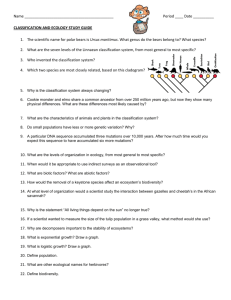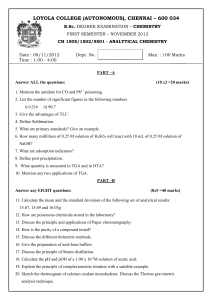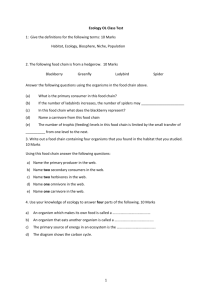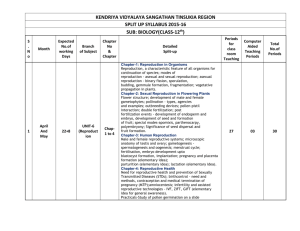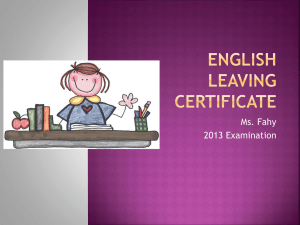B3 Revision (New Specification)
advertisement
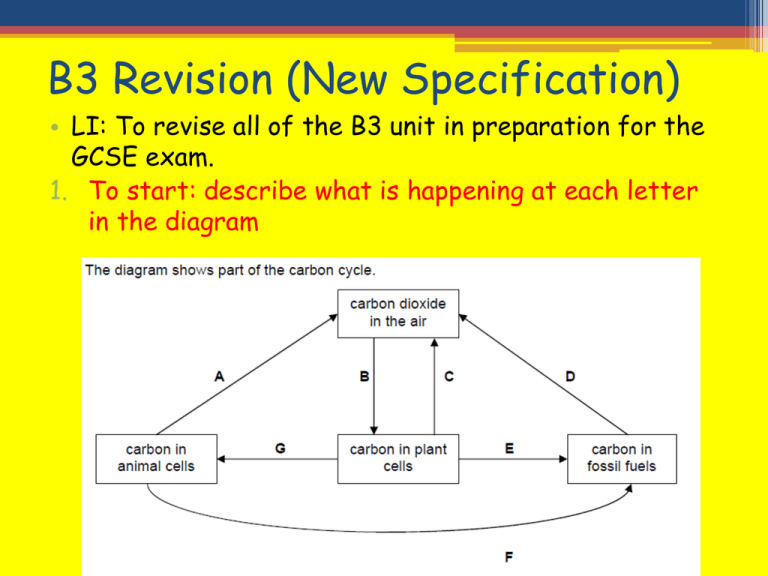
B3 Revision (New Specification) • LI: To revise all of the B3 unit in preparation for the GCSE exam. 1. To start: describe what is happening at each letter in the diagram Can you answer this question? (3 marks) Topics you need to know: • • • • • • • • • • • • Species and adaptations Extinction Energy Transfer in food chains/webs The Carbon Cycle The Nitrogen Cycle Indicators of environmental change Life on Earth and when it originated Variation and Evolution Natural Selection Lets go through Evidence for Evolution each of these Biodiversity topics in more Sustainability detail! Species and Adaptations • Can you answer the following: 1. What is the definition of a species? (1 mark) 2. What is an adaptation? (1 mark) 3. How is a cactus adapted to survive in hot and dry climates? (3 marks) 4. List 4 things animals/plants can compete for? (4 marks) 5. What does a food web show? (2 marks) 6. What is interdependence? (1 mark) Extinction • A species can become extinct if it is unable to adapt to a change in the environment, what could these changes be? (think of 4) Energy transfer in food chains • Almost all organisms are dependent on energy from the sun. • Plants absorb a small percentage of the energy from the sun to produce their own food via photosynthesis – the energy is then stored in the plant tissue. • Other organisms get energy from eating the plants and almost EVERY food chain starts with a plant. 1. Not all of the energy is passed on to the next organism in food chain, list 3 ways that this energy can be lost? (3 marks) 2. Why is their rarely a 4th level in a food chain? Remember: Percentage efficiency = energy in tissues Energy in food eaten x 100 The carbon cycle • Carbon is a key element in all living things and is continually recycled as follows: 1. Carbon enters the cycle as carbon dioxide from the air 2. Plants fix the carbon into their tissues by photosynthesis and these plants are eaten by animals or die and decompose 3. Carbon is returned to the air by respiration from plants and animals, decomposition by MO’s and by combustion of organic materials (fossil fuels) The Nitrogen Cycle • Nitrogen is essential to all living things. Nitrogen in air A Proteins in plants B D C Proteins in animals E F Nitrates in soil Describe what is happening at points A-F Indicators of environmental change • Non living and living indicators exist Non – Living Levels of Carbon Dioxide Temperature Nitrate levels in soil Living Phytoplankton Lichens (fungus and alga living together) Mayfly larvae • Scientists monitor change locally and globally • Living indicators provide accurate information about levels of pollution and environment changes e.g. Mayfly larvae need high levels of oxygen in water so if they are present suggest that there is little pollution Life of Earth • Life on earth began 3500 million yrs ago and the 1st life forms were very simple • Over many yrs these have formed the variety of organisms today via evolution • The changes to organisms over time is due to variation caused by their environment and their genes 1. What are the 2 pieces of evidence for evolution and which is more reliable? 2. Why are there some gaps in the records? Variation and Evolution 1. What causes variation in species? 2. What is a mutation? 3. Are all mutations harmful? • • Evolution involves the development of new species In a population of organisms the genes in the population will change due to mutations, this is known as the GENE POOL Natural Selection • This is the mechanism that Charles Darwin used to describe how evolution happens. How evolution happens (Copy and complete) • Variation exists between members of the same species. This is caused by their _______ , _______ and _______. Some individuals are born with characteristics that help them _________. These individuals will be more likely to _____ and pass on the ________ __________ to the next generation. This is an example of ______ __________ Natural Selection environment survival feature survive mutations breed genes How quickly does evolution happen? • Over a long period of time advantageous genes become the norm in a population. • There are examples of natural selection happening much faster: 1. Bacteria becoming resistant to antibiotics 2. Head lice becoming immune to medication Question: • What would happen to a group of the same species if they became isolated from each other on separate islands, would they be able to reproduce after many years apart? (3 marks) Charles Darwin Vs Lamarck Task: List the similarities and differences between their theories! Believed that species evolved over time via natural selection Believed that species had an ‘inner urge’ to change and so acquired new characteristics during their lifetime that were passed to offspring Biodiversity This is the variety of life on Earth including: • The number of species • The range of different types of plant/animal/microorganism • The genetic diversity (Variation) • The rainforest is very biodiverse and could be valuable for finding new medicines Question: • Species are becoming exist more rapidly than would be expected, what could be causing this? (4 marks) Sustainability • This is meeting the needs of people today without harming the resources for future generations • BIODIVERSITY must be maintained to ensure sustainability! 1. Why is a monoculture not sustainable? 2. What can manufacturers do to make products as sustainable as possible?
